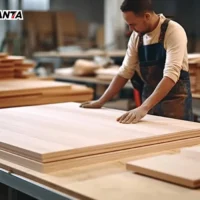Table of contents
What is Filmface Plywood?
Film face plywood is a type of plywood sheet that is coated with a durable, waterproof resin film. This film is usually made of phenolic resin, which provides a smooth surface that resists moisture, chemicals, and physical damage. The plywood underneath is typically made of hardwood or softwood, depending on the manufacturer’s specifications.
When it comes to construction materials, two types of plywood that are often discussed are filmface plywood and formply. While both are used for similar applications, such as formwork, they differ in several key aspects. Understanding these differences can help you choose the right material for your project.
Key Features of Filmface Plywood:
- Waterproof Coating: The resin film makes the plywood highly resistant to water and moisture, ensuring its longevity in wet conditions.
- Smooth Surface: The film provides a smooth finish, which reduces the amount of maintenance required during use.
- Durability: The film offers protection against abrasion and other physical damage, making the plywood suitable for demanding applications.
What is Formply?
Formply, short for “formwork plywood,” is specifically designed for use in concrete formwork applications. It is a type of plywood that is constructed to withstand the rigors of concrete pouring and the pressure associated with heavy-duty formwork. Like filmface plywood, formply also features a protective coating, but its main difference lies in its design and intended use.
Key Features of Formply:
- High-Strength Core: Formply is engineered with a robust core that is designed to support heavy loads during concrete pouring.
- Phenolic Coating: Similar to filmface plywood, formply typically uses a phenolic resin coating. However, the coating on formply is often thicker, making it more resistant to harsh conditions.
- Specifically for Formwork: Formply is manufactured to be used specifically in formwork applications, where high pressure and exposure to wet conditions are common.

Key Differences Between Filmface and Formply
While both materials are similar in many respects, there are distinct differences that make them suitable for different purposes.
1. Application
- Filmface Plywood: Filmface plywood is used in a variety of applications, from formwork to furniture, flooring, and outdoor structures. Its smooth, protective coating makes it versatile and suitable for both visible and hidden applications.
- Formply: Formply is specifically designed for formwork applications, particularly in the construction of concrete molds and structures. It is built to handle the high pressure exerted during concrete pouring, making it ideal for large-scale projects.
2. Coating Thickness
- Filmface Plywood: The film on filmface plywood is typically thinner and designed more for aesthetic purposes and basic protection against water and wear.
- Formply: Formply generally has a thicker, more durable resin coating that is specifically designed to withstand repeated use in concrete formwork. This extra thickness provides superior protection against abrasion, moisture, and concrete residue.
3. Durability and Longevity
- Filmface Plywood: While filmface plywood is durable, it is generally not as long-lasting as formply in highly demanding applications. It can be reused but is typically replaced after a few cycles of use.
- Formply: Formply is made to withstand the high demands of formwork, which often includes multiple cycles of use with exposure to wet concrete. The thicker resin coating makes it much more resistant to wear and tear, and it is typically used for many more cycles compared to filmface plywood.
4. Price
- Filmface Plywood: Because filmface plywood is often less specialized than formply, it is usually more affordable. It’s a great option for general-purpose projects where high durability in formwork isn’t a primary concern.
- Formply: Formply is generally more expensive due to its higher-quality, more durable construction. It’s a long-term investment that pays off in demanding construction projects, especially those involving repeated concrete pours.
5. Surface Quality
- Filmface Plywood: The surface of filmface plywood is smooth, which is important for projects that require a clean, aesthetic finish. It’s ideal for applications like flooring or furniture, where the appearance of the surface is critical.
- Formply: The surface of formply is often rougher, designed to provide more grip and support for concrete. It’s not intended for decorative applications, but it’s perfect for formwork where surface smoothness is less important than durability.
When to Use Filmface Plywood vs. Formply
- Filmface Plywood: Use filmface plywood for projects where a smooth, durable surface is needed, but the material won’t be subjected to the extreme conditions of formwork. It is great for furniture, cabinetry, flooring, and even general construction that requires water resistance and strength.
- Formply: Choose formply for formwork applications where concrete will be poured and the plywood needs to withstand heavy pressure and wet conditions. It’s perfect for creating molds and frameworks in large construction projects like bridges, high-rise buildings, and retaining walls.
Conclusion
Both filmface plywood and formply are essential materials in the construction industry, but they have distinct uses based on their composition and design. Filmface plywood is more versatile and suitable for a range of applications that require durability and water resistance, while formply is built specifically for the high pressures of concrete formwork and is ideal for large construction projects. Understanding the key differences will help you select the right material for your specific needs, ensuring that your project is both cost-effective and long-lasting.





















